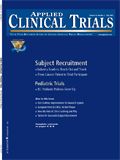FDA Moves to Update Research Enterprise
Applied Clinical Trials
High-quality programs needed to protect subjects, improve data, harmonize global trials, and manage costs.
Major changes in clinical trial operations over recent decades require a whole new approach to human subject research, according to FDA officials, research organizations, and study sponsors.

Jill Wechsler
The current clinical research system is "extremely inefficient and therefore expensive," commented FDA Deputy Commissioner and Chief Medical Officer Janet Woodcock. Research is overburdened by regulations, often fails to ask the most relevant clinical questions, and thus produces quality data only at a very high cost, she said at a Drug Information Association (DIA) workshop on "Defining and Implementing Quality in Clinical Investigations." The workshop took place in Washington in May to launch a broad effort to modernize clinical research practices and policies.
Just as Woodcock has spearheaded the FDA initiative to modernize policies for ensuring the quality of drug manufacturing and production, she and her colleagues want to apply quality risk management approaches to clinical research operations. A year ago (June 2006), Woodcock announced the FDA Human Subject Protection/Bioresearch Monitoring (HSP/BIMO) initiative to re-evaluate agency policies for regulating and inspecting clinical trials. The agency now seeks a more comprehensive re-evaluation of its policy and framework for clinical trial oversight as part of the Critical Path Initiative to modernize the scientific process for medical product development.
Today's costly research system prompts sponsors to conduct more studies overseas and discourages scientists and clinicians from entering the clinical research field, reported workshop participants from industry and academia. The growing number of foreign trials makes it even more difficult for resource-strapped FDA to inspect clinical sites. While fraud is rare, said Woodcock, when it is discovered, "it tarnishes the reputation of the research enterprise and erodes public trust." Such events make it even more difficult to attract patients to enter clinical trials, further adding to the complexity and cost of drug development.
Ensuring quality
FDA's response is to establish a Quality System for clinical research. Quality data, Woodcock said, should be sufficiently accurate to support FDA regulatory decisions, sponsor claims about a product, and treatment choices by physicians and patients. While absolutely perfect information is not realistic in a system with multiple parties and many sources of variation, a quality approach should be able to achieve an "acceptable control of variation" in clinical data, Woodcock explained.
This involves setting standards for conducting trials and collecting data; utilizing risk-based approaches to define acceptable levels of variation in results; automating data collection and transmission; adopting new methods for evaluating sites and investigator procedures; and updating regulations and guidances for all these areas. As with drug manufacturing, quality clinical research means building quality into research operations instead of relying on later oversight and inspections to verify data quality.
A concept paper prepared as background for the workshop [available under "new" at www.fda.gov/oc/initiatives/criticalpath] outlines a range of approaches for establishing a quality clinical research system:
Clearly define key protocol parameters to specify what data should be collected to answer important questions. A complete protocol should ensure appropriate study monitoring and review and clarify data collection, analysis, and monitoring. "It's not appropriate to put people at risk to answer junk science," commented ethicist Dale Hammerschmidt of the University of Minnesota. Sponsors have to ask the right questions in order to streamline data collection and avoid wasted efforts in analyzing and storing unneeded information, noted FDA official Rachel Behrman. "Nothing can make up for a bad protocol," she said.
Apply risk assessment to development programs. The scope of oversight for a research program may vary according to the nature of the disease under study, familiarity with the test product, the need to enroll vulnerable populations (children, foreign subjects), as well as investigator and site experience and structure. Preclinical safety data, pharmacology testing, and safety observations during Phase I and Phase II trials can guide clinical risk assessment in later development stages.
Enhance training for investigators, monitors, members of Institutional Review Boards (IRBs), and other research participants. Site certification programs are being considered for identifying those operations that meet standards; investigator certification similarly can help select experienced and capable researchers.
Expand the utility of data. Expand data beyond a single trial through collection and sharing of information via databases available to the research community; such a collective approach maximizes the utility of accumulated data and reduces unnecessary exposure of human subjects to research risks.
Targeting inspections
With clinical research sites proliferating around the world, FDA and sponsors find it increasingly difficult to monitor investigators frequently enough to ensure they follow good clinical practices and collect accurate, unbiased data. The situation is spurring interest in risk evaluation approaches that can help sponsors focus monitoring efforts on those sites with particular challenges or most likely to produce data affecting a product's safety profile or efficacy claims. The National Institute for Allergy and Infectious Diseases, for example, is looking to rate clinical trial protocols for riskiness to guide monitoring frequency.
As sites and sponsors adopt risk and quality approaches, FDA sees itself shifting from direct inspection to more of an audit function designed to ensure that a quality research system is functioning as expected. It may be appropriate to utilize remote or electronic monitoring systems for low risk sites. Site certification also could identify operations that warrant reduced oversight, but requires considerable work by the research community to address what standards will be used, who will do the certification, and what component will be certified—individual investigator or research organization.
Going electronic
A key imperative for a modern clinical research system is to shift from a paper-based to an electronic information system—a move that requires standards for common case report forms, adverse event reports, electronic medical record systems, and reporting nomenclature. Sponsors currently use different computer systems with different data conventions, which is inefficient and increases the potential for errors.
FDA supports efforts to develop disease-specific phenotype data standards and to establish more standardized research endpoints, including markers for imaging tests, laboratory assessments, and clinical outcome definitions. An FDA guidance on using computerized systems in clinical investigations, issued May 2007, describes procedures for handling and ensuring integrity of electronic data.
The Clinical Data Interchange Standards Consortium (CDISC), which heads up the Clinical Data Acquisition Standards Harmonization (CDASH) project, provides the central forum for collaborative efforts to standardize and automate the collection and management of clinical data. Success in this area will simplify data collection and entry by investigators and site personnel, ultimately through integration of research into electronic health record systems. One prime initiative is to develop a standard case report form—an initiative that would help shift from today's wide range of forms and formats, most of which are submitted on paper to FDA and other regulatory authorities.
A Collaborative Group oversees the project, which includes representatives of clinical research organizations, investigators, pharmaceutical companies, FDA, academic research organizations, and data management firms. The group is developing a set of content standards (element name, definition, metadata) for a core set of global data, which hopefully will be reviewed by the end of the year, according to CDISC Director Rebecca Kush. A future task would be to develop standards for specific therapeutic areas.
Next steps
Following the May workshop, FDA and the research community plan to prepare a White Paper on the components and importance of global quality clinical research. Meanwhile, FDA is weighing the need to undertake rulemaking to revise certain aspects of its 30-year-old regulations, such as penalties for parties that falsify data. The agency recognizes the need for more guidance in this area and hopes to finalize draft policies for adverse event reporting to IRBs and on supervisory responsibilities of investigators. Additional guidance may clarify FDA's policy for assessing patient-reported outcomes and for filing, storing, and retaining electronic clinical data.
Sponsors urge further international harmonization of quality research standards and risk-based approaches through the International Conference on Harmonization, as is being done for drug manufacturing. There is a need for more "alignment of stakeholders," including those in the United States and Europe, as well as among FDA field and review staffs, commented Mark Behm of AstraZeneca. With costs rising and the media and Congress zeroing in on trial operations, industry is championing a more risk-based approach that clarifies research requirements and offers more value to patients.
Jill Wechsler is the Washington editor of Applied Clinical Trials, (301) 656-4634 jwechsler@advanstar.com
FDA Fast Tracks Johnson & Johnson’s Nipocalimab for Fetal Neonatal Alloimmune Thrombocytopenia
March 27th 2024Johnson & Johnson is moving forward with a pair of Phase III trials of nipocalimab to reduce the risk of fetal neonatal alloimmune thrombocytopenia in alloimmunized pregnant patients.
